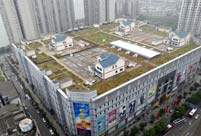 |
| Lü Kejian. Photo: Li Hao/GT |
Pollution protection
Lü said that his DIY trees belong in ordinary people's homes, because they can work as an air humidifier and air purifier. "The device can be popularized because all the apparatus can be manufactured according to my engineering drawings," he explained.
The couple has started regularly recording the PM 2.5 air pollution figures in the outdoor environment near his home, in his apartment and in his neighbor's apartment, which has no trees. They want to prove that the plants can help reduce PM2.5 levels and the associated health risks.
"People spend most their time in their homes, and that is why tackling the indoor PM 2.5 problem is so important," he said.
According to their data, the PM 2.5 figures in his living room are much lower than in his neighbor's room or outside. For example, on August 27 when Metropolitan visited, the outdoor PM 2.5 figure was 105 ug/L, while his home was 27 ug/L at 8 pm.
He is satisfied with the result, because "the data is lower than the level required by World Health Organization, which is the 35 ug/L."
In April 2012, environment protection volunteers from Green Beagle, a Beijing-based NGO, came to his home, and made a comparison of the PM 2.5 data in and outside. Their monitor also suggests that Lü's home has fewer particles in the air.
Feng Yongfeng, an environmentalist and founder of the Green Beagle, said residents' personal hobbies nurturing plants should be encouraged. In his opinion, however, the more fundamental measures for tackling the city's PM 2.5 problem depend on the government's efforts to reduce pollution.


 Int'l Military Music Festival kicks off in Moscow
Int'l Military Music Festival kicks off in Moscow Army aviation brigade in actual-troop drill
Army aviation brigade in actual-troop drill Top 10 Chinese provinces for the well-heeled
Top 10 Chinese provinces for the well-heeled  Baby born to save his sister - the story of a savior sibling
Baby born to save his sister - the story of a savior sibling Lady of mystery: Female SWAT team in prison disclosed
Lady of mystery: Female SWAT team in prison disclosed  Single mother, baby live in KFC restaurant for months
Single mother, baby live in KFC restaurant for months Fan Bingbing poses for Malaysian magazine Citta Bella
Fan Bingbing poses for Malaysian magazine Citta Bella Zhang Xinyi covers COSMOPOLITAN
Zhang Xinyi covers COSMOPOLITAN A collection of bizarre rooftop buildings around China
A collection of bizarre rooftop buildings around China Egyptian forces step up crackdown campaign on smuggling tunnels
Egyptian forces step up crackdown campaign on smuggling tunnels China, U.S. conduct joint anti-piracy drill
China, U.S. conduct joint anti-piracy drill  'Abandoned' life in cement boats in Huai River
'Abandoned' life in cement boats in Huai River 2013 Taiwan Int'l Tourism Expo kicks off in Taipei
2013 Taiwan Int'l Tourism Expo kicks off in Taipei Photo story: Take a gap year
Photo story: Take a gap year Nokia's Global Headquarters: visiting a declining empire
Nokia's Global Headquarters: visiting a declining empireDay|Week|Month